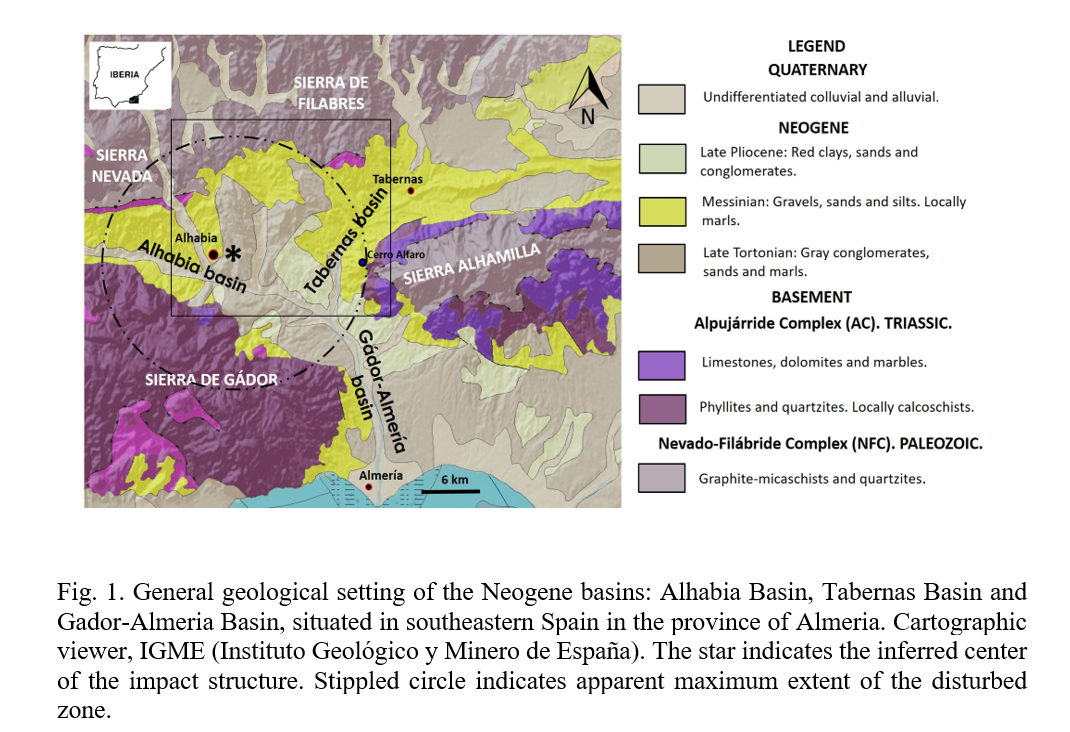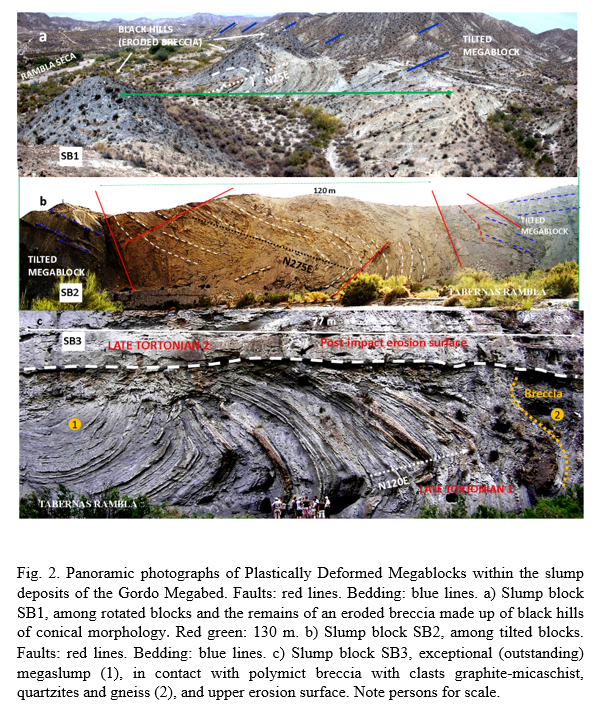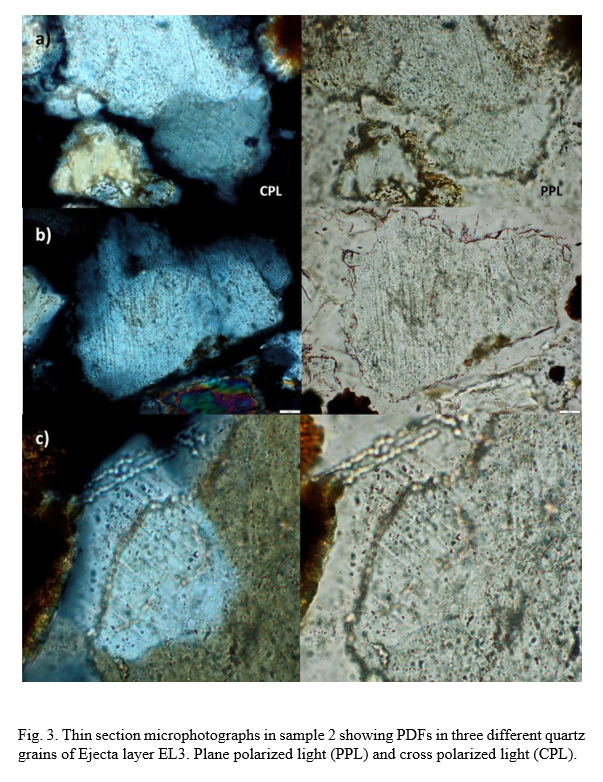A probable impact structure in Betic Cordillera, Almeria, SE Spain
- 1Dpto Agronomía. Universidad de Almería, Almería, Spain (jasanche@ual.es)
- 2Centro Astrobiología. Instituto Nacional Técnica Aeroespacial-Consejo Superior Investigaciones Científicas, MADRID, Spain (ormoj@cab.inta-csic.es)
- 3Department Geology. Lund University, Lund, Sweden (carl.alwmark@geol.lu.se)
- 4Niels Bohr Institute, Copenhagen University, Kobenhavn, Denmark (sanna.alwmark@geol.lu.se)
- 5Eurogeologist, Málaga, Spain (robertlilljequist@gmail.com)
INTRODUCTION
The Tabernas Basin (Betic Cordillera) is filled with Neogene, Pliocene and Pleistocene sediments, discordant on a metamorphic basement (Fig. 1). During the Tortonian sedimentation an up to 70 m thick bed of breccia (the Gordo Megabed) was deposited. It consists of up to several tens of meters large, rotated sedimentary megablocks frequently capped and/or surrounded by a polymict breccia of mainly up to m-sized clasts of the crystalline (schist) basement. Previous workers have suggested the bed to be a seismite. The polymict composition of the studied breccias intercalated within the otherwise shallow-marine sediments, the presence of megablocks, plastically deformed megablocks and shock metamorphic features in quartzs of polymict breccias have led us to the description and reinterpretation of sediments and geomorphological features in the Tabernas Basin that could be related to an impact structure.

MATERIALS AND METHODS
Multiple field studies were carried out over the course of several years to study the geology and geomorphology of the Tabernas Basin and its surroundings with special focus on the Gordo Megabed. These studies were carried out in conjunction with geological mapping and the measurement of parameters of the observed geological structures.
Thin sections (97 in total) from the different lithologies and locations were prepared and studied for shock metamorphic features under an optical microscope. Quartz grains displaying planar features were studied using the techniques described in Stöffler and Langenhorst (1994) and Ferrière et al. (2009).
RESULTS
Megablocks
We define megablocks as coherent rock blocks that are tilted or rotated, lithologically homogeneous, and that extend in outcrops over at least 30 meters (i.e. having dimensions of several tens of meters).
The material of the megablocks is often made up of sets of turbidites belonging to the Gordo Megabed and three zones have been identified and mapped:
- Zone 1: Central part of the Neogene basin of Tabernas (Rambla de Tabernas).
- Zone 2: Borders to zone 1 to the east and features such as Cerro Alfaro.
- Zone 3: Neogene basin of Alhabia, on the northern flanks of Sierra de Gador.
Plastically Deformed Megablocks
Only three outcrops of these structures SB1, SB2 and SB3 (Fig. 2). They involve recumbent folds with reverse limb whose fold axes follow the direction: N25E, N275E and N210E. They represent plastic internal deformation of the within the slump unit mobilized stacks of Late Tortonian turbiditic marl and sandstones beds, inclined to the NE, W and SW and their directions do not match the main tectonic structures that formed these Neogene basins E-W to NE-SW (Martínez et al., 2017).

Polymict breccias
Most of the polymict breccias studied (28 in total) are located at the Rambla de Tabernas and present a single lithostratigraphic, mainly graphite-micaschist, quartzite and gneiss, as well as brecciated dolomite. These breccias are massives, unstratified, clast supported and lacks visible sedimentary structures. The angular shape of the fragments indicates short transport, but the basement clast lithologies of the breccia originates far from the present locations.
Breccia 29 is in an anomalous stratigraphic position on Triassic phyllites in Sierra Alhamilla. This is a variable 10-50 cm thick deposit of Neogene material (loams, sands and limestones).
Breccia 30 (sample 2) is located in Sierra de Gádor and constitutes an intermixture of different materials, from both the metamorphic substrate and the Neogene sedimentary sequence.
These features in both breccias could be compatible with a proximal ejecta layer and may clearly be identified by the presence of shock-metamorphic features (Osinski et al., 2013).
Shock-metamorphic features
The systematic search for quartz grains with shock metamorphic features in breccias, resulted in six quartz grains, five grains displaying one set of planar features and one grain with two sets. The features are straight, parallel, sets of planes with a typical spacing between each plane of 1-5 μm. The planar features penetrate the entire grain in four cases, and in two cases they were only visible near the grain boundary in part of the host grain. The features are generally fresh, but occasionally decorated, i.e., lined by minute fluid inclusions (Fig. 3).

Nevertheless, in light of the indicative, albeit not affirmative, presence of a shocked quartz grains in what we find as analogous lithologies to known impactites based on their composition, appearance, stratigraphic position and geographical distribution, as well as the other sedimentological, stratigraphic, petrographic and geomorphological observations, lead us to propose the existence of a possible impact crater in the Tabernas Basin of Almeria. In our model, the crater is still to large parts preserved, but covered by post-impact materials, which only leaves an already heavily eroded part of the structure visible on the eastern edge.
CONCLUSIONS
A comparison with established impact craters showing similar geological features suggests that the Tabernas Basin still holds a well-preserved, concentric impact structure with a mainly buried, 8-km wide nested crater in the basement surrounded by a 22-km wide, outer crater formed by extensive gravitative collapse of a tens of meters thick, upper target layer of semi-consolidated sedimentary strata, likely in a shallow aquatic paleoenvironment.
REFERENCES
Ferrière, L., Morrow, J. R., Amgaa, T. Koeberl, C. 2009. MAPS 44:925–940.
Martínez, M., Galindo, J., Martínez, F. J. 2017. International Journal of Earth Sciences 106 (7), 2461-2471.
Osinski, G. R., Grieve, R. A. F., Tornabane, L. L. 2013. In Impact Cratering: Processes and Products. Osinski G. R. and Pierazzo E. Eds. Wiley-Blackwell Publishing.
Stöffler, D., Langenhorst, F. 1994. Meteoritics 29(2):155–181
How to cite: Sánchez Garrido, J. A., Ormö, J. O., Alwmark, C., Alwmark, S., Zachen, G., Lilljequist, R., and Sánchez Gómez, S. T.: A probable impact structure in Betic Cordillera, Almeria, SE Spain, Europlanet Science Congress 2022, Granada, Spain, 18–23 Sep 2022, EPSC2022-217, https://doi.org/10.5194/epsc2022-217, 2022.

